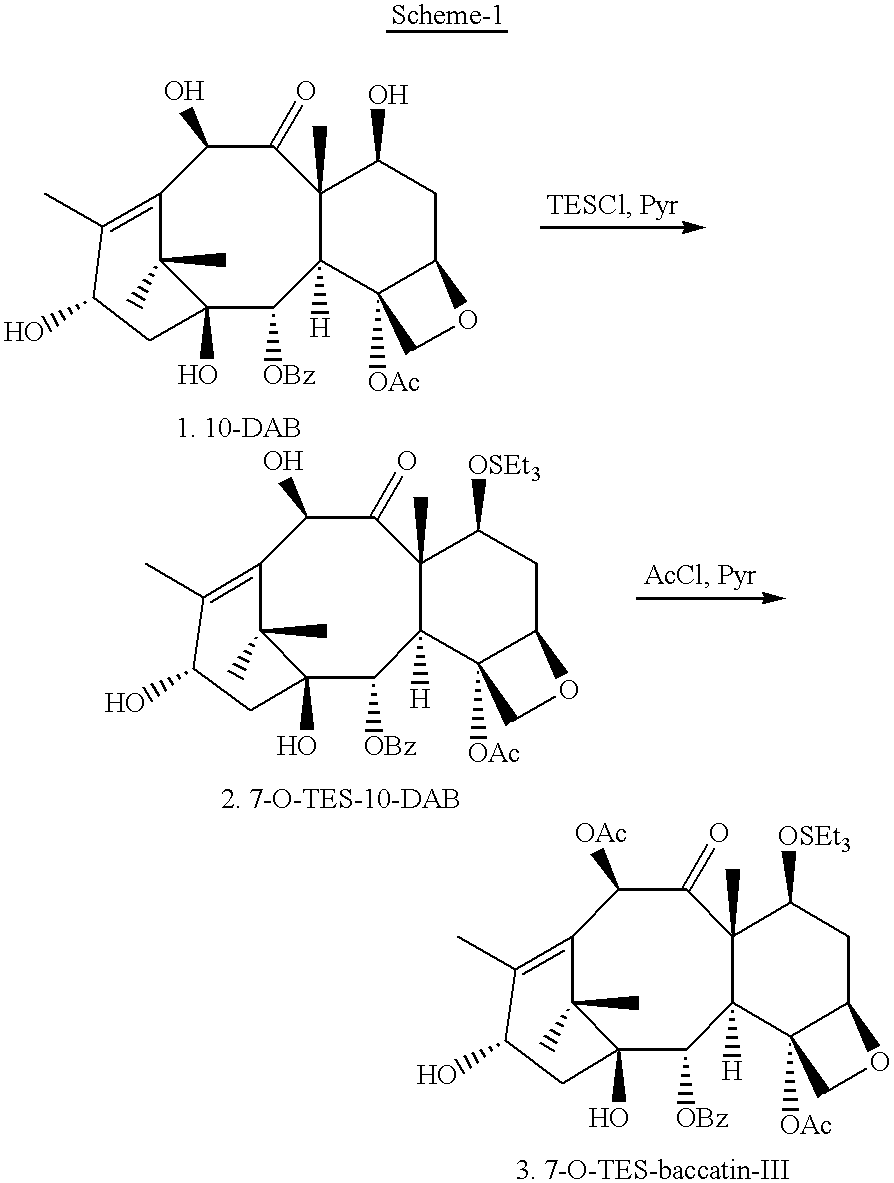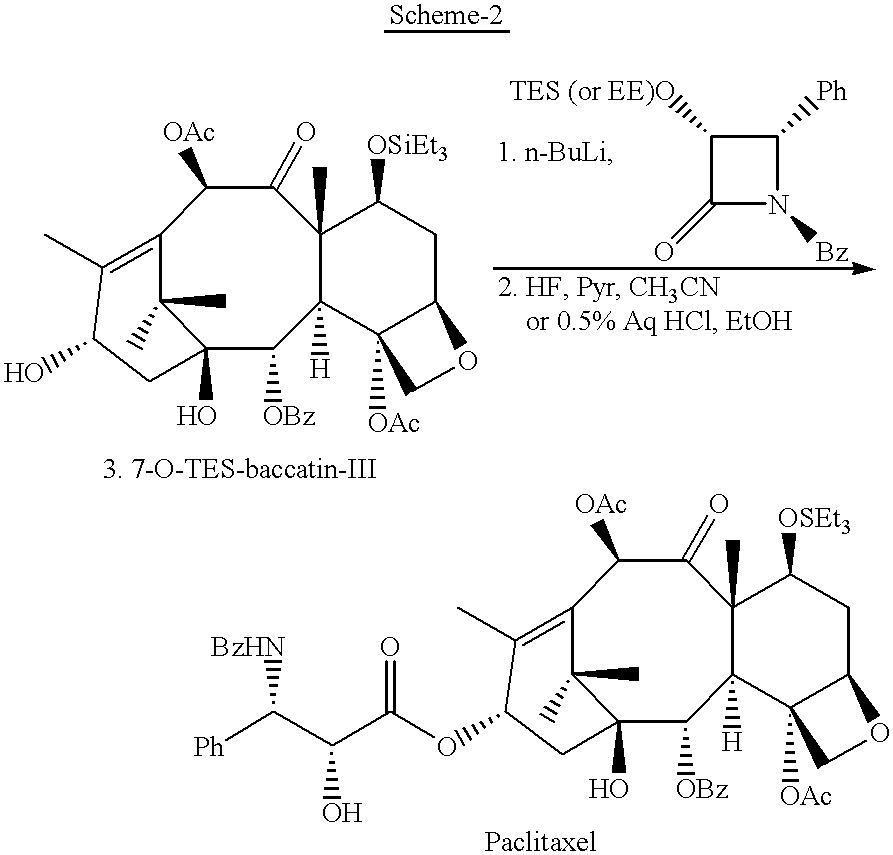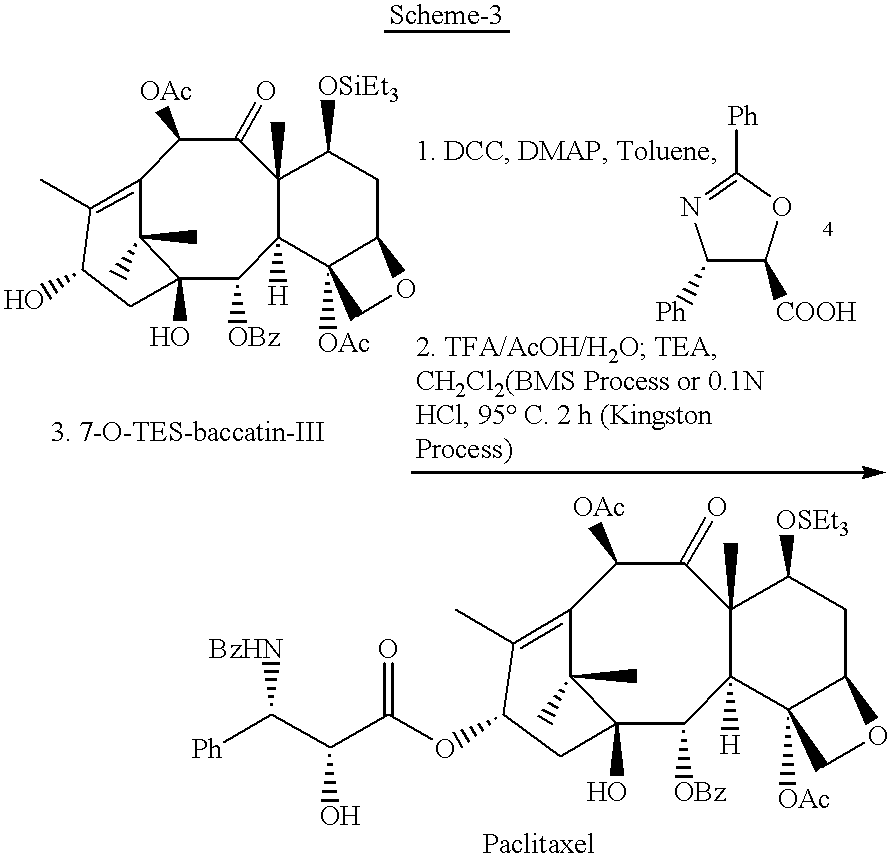Semi-synthesis of paclitaxel using dialkyldichlorosilanes
- Summary
- Abstract
- Description
- Claims
- Application Information
AI Technical Summary
Benefits of technology
Problems solved by technology
Method used
Image
Examples
example 1
General procedure for formation of 7-OSi(R).sub.2 (OR')-10-DAB
10DAB is dissolved in DMF. Imidazole was added, and to the resulting solution the dialkyldichlorosilane was added and the disappearance of 10-DAB was monitored by HPLC. When no 10-DAB remains, the appropriate alcohol was added, and the reaction was allowed to stir at rt for 1 hour. The reaction mixture was poured into MTBE, washed 3 times with water and concentrated to give the desired compound.
7-OSiEt.sub.2 (OMe)-10-DAB (7):
To a stirred solution of 10-DAB (1, 1 g, 1.84 mmol) and imidazole (0.413 g, 6.07 mmol) in dry DMF (12 ml) was added diethyldichlorosilane (0.326 ml, 2.18 mmol) at -53.degree. C. under argon. As thick solids were formed after 10 min, another portion of DMF (6 ml) was added and the stirring was continued for 2 h. Methanol (0.12 ml, 2.96 mmol) was added at -53.degree. C. The reaction was stirred an additional 1 h at -53.degree. C., then allowed to warm to RT over one hour. The reaction mixture was dilute...
example 2
A. General Procedure for the acetylation of 7-O-silyl protected 10-DAB compounds
LiHMDS in THF (0.7 eq) was added over a minute to a stirred solution of 7-OSi(R).sub.2 (OR')-10-DAB in THF under Ar at -45.degree. C. After 10 min, acetylimidazole in THF (9.07%; 2 eq) was added over a min and stirred for 3 min at -45.degree. C. Then, the reaction flask was placed in a cryocooler at -25.degree. C. and stirred at that temperature until the reaction was complete (1.25-6 h). The reaction mixture was diluted with MTBE (15 ml) and washed with 10% NaH.sub.2 PO.sub.4 (2.times.5 ml), water (2.times.5 ml) and brine (1.times.5 ml). The MTBE phase was dried over Na.sub.2 SO.sub.4 and evaporated to give a solid baccatin-III product. Using this procedure, following examples were prepared.
7-OSiEt.sub.2 (OMe)-baccatin-III (27):
7-OSiEt.sub.2 (OMe)-10-DAB (7, 125 mg, 0.19 mmol) in THF (3 ml) was subjected for the above acetylation procedure for 6 h to give the title compound (27, 0.129 g) in 96.7% yield....
example 3
Paclitaxel from the BMOP route:
LiHMDS in THF (1M, 43 ml, 0.043 mmol) was added to a stirred solution of 7-OSiEt.sub.2 (OCH.sub.2 CF.sub.3)-baccatin-III (32, 30.2 mg, 0.039 mmol) in dry THF (1.5 ml) at -55.degree. C. under argon. After 5 min of stirring, BMOP ((3R-cis)-Benzoyl-3-(1-methoxy-1-methylethoxy)-4-phen-yl-2-azetidinone) (17 mg, 0.05 mmol) in dry THF (0.5 ml) was charged over 2 min to the reaction mixture at -55.degree. C. and stirred for 5 min. The reaction flask was removed from the cryocooler and placed in an ice bath and stirred for 4.7 h. HPLC showed a 86.4% conversion to 39. A solution of TFA (0.049 g, 0.43 mmol), water (0.252 ml, 14 mmol) and AcOH (0.822 ml, 14.35 mmol) was added and hydrolyzed the reaction mixture for 17 h. The reaction mixture was evaporated to a residue, which was purified by silica gel chromatography using hexane:EtOAc (2:3) to provide 24.2 mg of paclitaxel (HI: 84% with 12.2% of baccatin-III).
Compound 41:
A mixture of 7-OSiEt.sub.2 (OCH.sub.2 CF.s...
PUM
 Login to View More
Login to View More Abstract
Description
Claims
Application Information
 Login to View More
Login to View More - R&D
- Intellectual Property
- Life Sciences
- Materials
- Tech Scout
- Unparalleled Data Quality
- Higher Quality Content
- 60% Fewer Hallucinations
Browse by: Latest US Patents, China's latest patents, Technical Efficacy Thesaurus, Application Domain, Technology Topic, Popular Technical Reports.
© 2025 PatSnap. All rights reserved.Legal|Privacy policy|Modern Slavery Act Transparency Statement|Sitemap|About US| Contact US: help@patsnap.com



